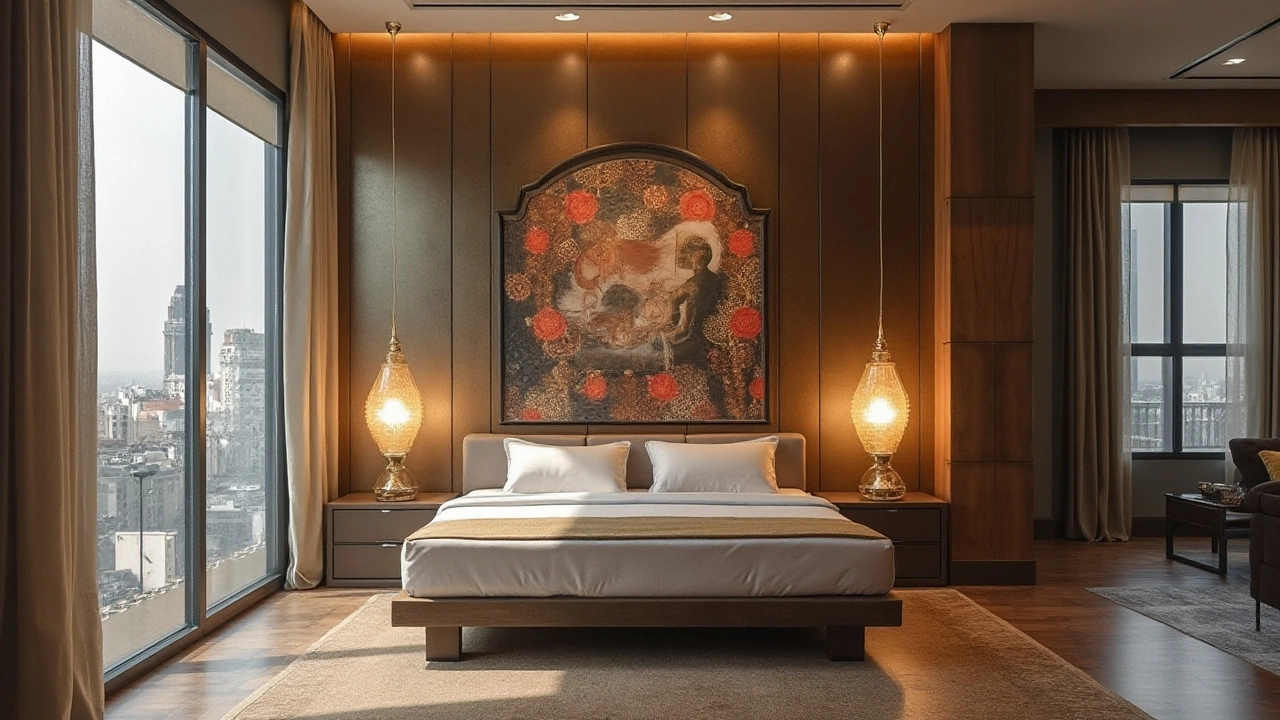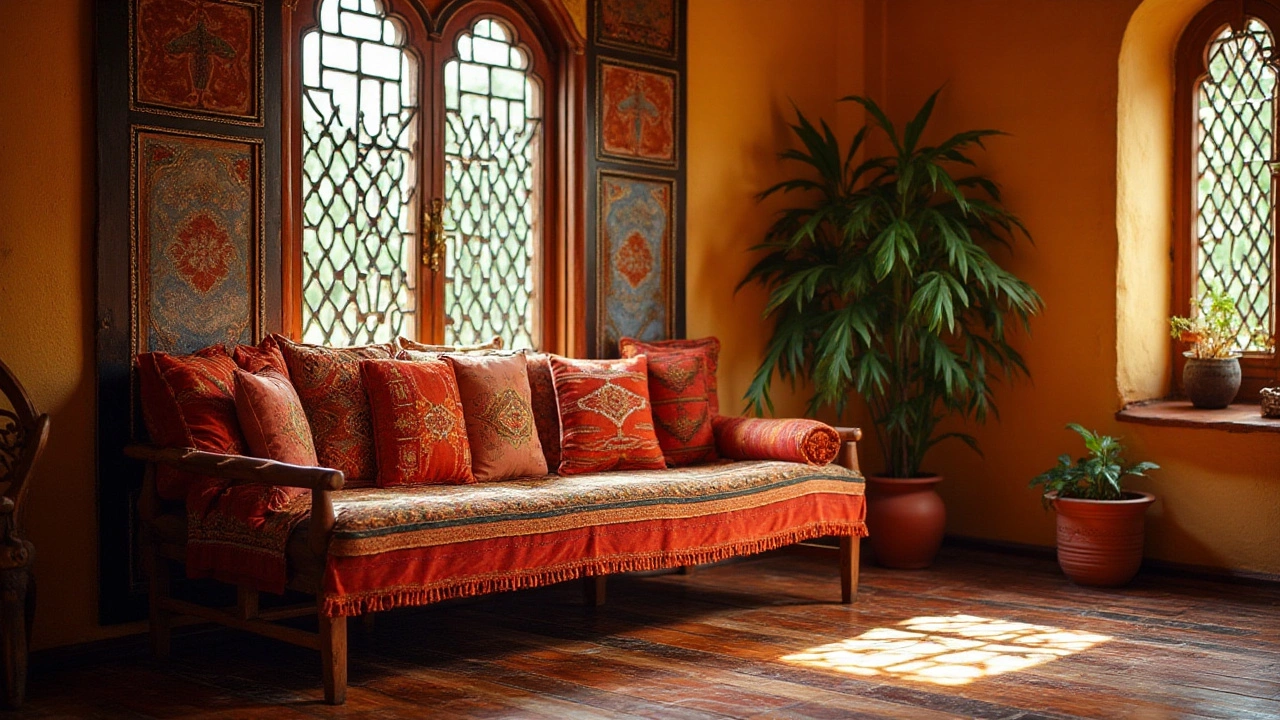In the quest for comfort and utility at home, two popular contenders often emerge: futons and sofa beds. Both offer the appealing combination of seating by day and a sleeping area by night. Yet, they each come with their own set of features and benefits.
When considering which might be more comfortable, it's important to think about your personal needs and lifestyle. Do you favor versatility, or is a night of sound sleep your biggest priority? Perhaps aesthetics are high on your list, or maybe the ease of setup ranks supreme in your book. Each option offers unique attributes that could sway your decision, and by comparing them side by side, you can bring out the best choice for your own home sanctuary.
- The Basics: Futons and Sofa Beds Explained
- Design and Style Considerations
- Comfort Levels: Sitting and Sleeping
- Practicality and Usage
- Space and Portability
- Choosing What’s Right for You
The Basics: Futons and Sofa Beds Explained
Delving into the world of home furniture, futons and sofa beds often make their mark as versatile pieces designed to maximize space without compromising on style or comfort. Both have been the go-to solutions for small apartments, guest rooms, and multi-functional living spaces. However, they stand apart with distinct differences that cater to varied needs and preferences.
A futon traditionally symbolizes a minimalist style. Originating from Japan, a futon is primarily a thin mattress laid directly on the floor and rolled up during the day. However, as it made its way across the globe, it transformed. Now, the typical futon in Western homes has become a bed-like frame with a foldable mattress, offering a seating solution during the day and sleeping space at night. The mattress is usually made from cotton or synthetic fibers, which adds to its portability and ease of storage. The design of a futon often includes a wooden or metal frame, which adds a touch of elegance to its functional nature. As Arthur Fleck, an interior designer, once said,
"A futon seamlessly blends function with simplicity, ensuring that your living space remains stylishly uncluttered."
On the other hand, sofa beds are tailored for those who prioritize sophistication and convenience. Unlike futons, a sofa bed looks just like a regular couch, with a hidden bed mechanism lurking underneath its cushions. This clever design allows it to blend in as a permanent part of the living room decor. Most sofa beds feature a pull-out system that reveals a mattress, which can be made from memory foam or traditional spring materials, ensuring a more traditional sleeping experience. They often come in diverse styles and sizes, offering options from a twin to a queen-sized bed, fitting into various room configurations. The upside here is the plush comfort when seated, making it an ideal spot for lounging with friends, watching a movie, or reading a book.
When it comes to the functionality of futons and sofa beds, there are several factors at play. Futons are remarkably lightweight and can be easily moved or adjusted within a room, offering great flexibility in terms of arrangement. Contrarily, sofa beds are known for being heavier, often requiring more effort to transform from couch to bed mode. Their assembly can sometimes become a game of Tetris – granted, some might see it as a small sacrifice in exchange for the seamless design integration and heightened comfort levels.
In terms of cost, there's a noticeable variance. Futons often come across as the more budget-friendly option, appealing to students or young professionals who are just setting up their first nest. In comparison, sofa beds tend to sit on the higher end of the price spectrum, attributed to their intricate mechanisms and luxurious designs. As such, the choice often boils down to personal preference, financial considerations, and the primary use of the furniture piece.
If we look at consumer trends, a recent survey showed that 65% preferred sofa beds for their primary home, whereas futons were favored by 35%, indicating a strong inclination towards more permanent, aesthetically pleasing options. This dynamic shift suggests a growing demand for furniture pieces that not only serve a functional purpose but also contribute to the overall aesthetic appeal of a home.
Design and Style Considerations
Choosing between a futon comfort and a sofa bed often comes down to what suits your aesthetic and lifestyle the best. With an array of designs, these pieces fit into various decor themes, ranging from sleek modern flats to cozy, traditional homes. Futons, with their minimalist design and simple frames, often appeal to those who appreciate a more flexible and eclectic style. Unlike sofa beds, futons have a more casual vibe, making them an ideal choice for a relaxed living area or a college dorm room.
Sofa beds, on the other hand, offer a more formal appearance and often blend seamlessly with conventional seating arrangements. They're often crafted from plush materials, adding an element of luxury to your space. A sofa bed with a solid, tailored structure fits well in spaces where a more refined look is desired. Their ability to mimic the aesthetics of a traditional sofa during the day could be the perfect solution if you host gatherings and want to maintain a certain elegance in your space. In the end, it really is about gauging what fits your personal taste and home environment best.
"Design is not just what it looks like and feels like. Design is how it works." - Steve Jobs
When deliberating between these two, consider the range of materials and colors available. Futons are often designed with lighter frames of metal or wood, paired with interchangeable mattresses that can be swapped out with covers of various patterns and textures. This adaptability is favorable for those who like to switch up styles without a major investment. Sofa beds, meanwhile, typically come with built-in upholstery, giving them a more consistent look, and are available in an extensive array of colors and fabrics, including leather and microfiber.
A critical point to notice is how these sleeping furniture items handle space. Futons often feature a more straightforward mechanism; you simply fold them down into a bed. Their compact frames mean they fit snugly into small spaces, making them especially useful for city apartments where every square foot counts. In contrast, sofa beds can be bulkier owing to their pull-out mattresses. They might require more room to maneuver when converting into beds, but they offer a sturdier sleeping surface which is a major comfort boost.

Comfort Levels: Sitting and Sleeping
When it comes to finding the perfect balance between seating and sleeping, futon comfort and sofa bed convenience often top the list of considerations. Though both pieces are multifunctional, they offer different experiences that cater to varied preferences. Starting with futons, these versatile pieces have been a staple in many households. Traditionally hailing from Japan, futons often consist of a simple frame with a cushioned mattress that can be folded into a couch or laid flat as a bed. Modern futons vary greatly in terms of quality and design—ranging from basic models with thin mattresses to plush, luxurious styles that vie for attention in cozy, contemporary living spaces.
In terms of sitting, futons can be quite comfortable if you opt for a well-padded model. The mattress plays a crucial role in determining comfort, as a thicker, high-quality mattress will provide better support during those long movie nights. However, some users might find that the lack of built-in springs or cushioning in simpler futons can make them feel less supportive than a traditional sofa. Conversely, the appeal of a sofa bed lies in its integration of design and convenience. Typically designed as standard couches, sofa beds come with the added advantage of a neatly tucked-away mattress that can be unfolded at bedtime. The comfort level while sitting depends heavily on the primary purpose of the sofa bed.
If the piece is designed more for sleeping, as opposed to lounging during the day, the seating cushions might feel stiffer and less yielding. Yet, more luxurious models expertly blend both sitting and sleeping comfort, ensuring the structure doesn't compromise on either.
Turning the sofa bed into a sleeper is generally simple, as most designs incorporate mechanisms to easily pull out the bed. This elegance can be a major selling point for some, especially for those who need to accommodate guests frequently.
According to Furniture Today, a leading industry publication, "the global demand for dual-purpose furniture has led to significant advancements in design and comfort, allowing furniture to seamlessly adapt to the dynamic needs of modern living."
Looking at the sleep aspect, both furniture types possess their own merits. Futons, when equipped with a premium mattress, can offer a surprisingly restful sleep. Yet, they tend to remain firm, which may not suit everyone. On the other hand, sofa beds usually come with a cushioned innerspring or memory foam mattress for enhanced comfort. The quality here can vary widely, depending on the price point. It's worth noting, sofas designed with better sleep quality in mind could rival regular beds in terms of restfulness and support.
Intriguingly, a 2020 survey by the Home Furnishings Association found that nearly 40% of buyers prioritize comfort over all other factors when purchasing sleeping furniture, underscoring the importance of trying before buying. Whether you prioritise cushioning for seating or support for sleeping, your choice will be personal and influenced by specific needs and preferences.
Practicality and Usage
When considering practicality and usage, both futons and sofa beds come into play differently, each offering their own unique benefits. Futons, though often lightweight and easy to move, might feel a bit old-school to some. Their Japanese roots emphasize minimalism, making them a top choice for people who want to maintain open space or frequently change their room layout. Many college students and young professionals opt for futons because they are relatively easy to set up on their own, making them perfect for first apartments or dorms. A futon can be as simple as a mattress stretched over a frame that folds flat. Its simplicity is its charm, providing a no-frills solution that emphasizes functionality over flair.
Sofa beds, on the other hand, may appear bulkier, often resembling a traditional sofa when in their sitting configuration. This disguise is their strong suit, allowing them to blend seamlessly into the living room or guest room aesthetic. They often involve a more complex mechanism—a fold-out mattress tucked beneath sofa cushions, elevating the sofa bed to a more polished piece of furniture. This transformation from sofa to bed often requires some effort, like removing the sofa cushions to reveal the mattress. However, the payoff can be significant, with the added layer of comfort and thick cushioning offering a plush sleeping experience. Though a bit heavier, they serve as a convenient choice for those anticipating overnight guests frequently.
Space Optimization
Space optimization is an important factor when it comes to deciding between a futon and a sofa bed. Futons are typically more adaptable to smaller areas due to their simplistic design. A futon set against a wall can quickly morph into a bed, making it an ideal choice for studio apartments or rooms with restricted space. Sofa beds might require a bit more planning, as their need for space to extend means measuring the potential room before purchase is advisable. An interesting fact to note is that, according to a recent survey, about 45% of homeowners choose a sofa bed primarily because it doubles as an elegant piece of decor while serving a functional role.
"A well-chosen sofa bed can transform an ordinary living area into a multifunctional space," notes interior designer Jane Roberts.The practicality of both pieces pivots on how you intend to use your space and what level of comfort you expect from them once deployed. This decision is crucial for maximizing the utility of any given room.
Consider ease of maintenance—futons generally come with removable mattress covers that can be washed, making them user-friendly. Meanwhile, sofa beds might require more involved cleaning routines, especially if fabric cleaners become necessary to keep them looking their best. Some modern sofa beds feature innovative materials that make maintenance easy, but this might come at a higher cost. Therefore, personal preferences and lifestyle should be the primary guiding factors when choosing between the two.

Space and Portability
The dilemma of choosing between a futon and a sofa bed often gets more complicated when considering space efficiency and portability. For those navigating compact living arrangements such as studio apartments or dorm rooms, the use of space becomes a major consideration. A futon usually comes out on top in such scenarios, thanks to its typically sleek and minimalist design. Unlike a traditional sofa bed, which employs a built-in pull-out mattress mechanism that can be cumbersome, futons offer a straightforward fold-down functionality. This makes them not only easier to maneuver within tight spaces but also a breeze to move from one location to another.
Sofa beds, while bulkier, serve a different utility in terms of space utilization. They often offer a more substantial seating area, which could accommodate more people when entertaining guests. As they look and function like a standard sofa, they might better suit settings where they are primarily used for seating. However, their heavy built-in mechanisms can make relocation a challenge. Those who frequently rearrange their living space might find sofa beds less accommodating, given that they typically require a little more manpower to adjust.
"The choice between a futon and a sofa bed should be informed by how flexible your living requirements are," notes interior designer Sarah Benjamins. "While futons are fantastic for adaptable spaces, sofa beds provide unparalleled comfort when set up permanently."
From a portability standpoint, the future owner of these pieces should weigh how often they anticipate needing to shift or move their furniture. Futons typically dismantle with ease into a lower weight frame and a separate mattress, allowing them to be transported with relatively few logistics involved. On the other hand, sofa beds are often a more permanent fixture due to their heft and integrated construction. Yet, they can be the ideal solution for those who move less frequently, passionate about having a seamless blend of function and form.
If an on-the-go lifestyle or frequent home reorganization piques your interest, consider measuring your room dimensions carefully and envisioning the transformation of your space with either choice. Balance what suits your storage solutions too – however slight, foam futon mattresses might need periodic airing if unused in storage, but sofa beds always offer a perfect extra guest bed in minutes. Remember, space and portability don't just refer to dimensions and weight. They're about integrating a fitting piece into the dynamics of your life, making every square foot work for you.
Choosing What’s Right for You
When it comes to selecting between a futon and a sofa bed, the choice largely depends on your personal preference and the specific needs of your living space. Each option carries its own charm, and what works for one person might not necessarily be ideal for another. First off, consider the space you have at hand. Sofa beds are typically bulkier due to the internal mattress mechanism, which can make them slightly more cumbersome in tight quarters. Futons, on the other hand, are appreciated for their flexibility and minimalist design. They are lightweight and can be easily repositioned within a room or even moved from one location to another without much hassle.
The aesthetics of your home also play a significant role in your decision. Futons often come with a wide range of covers and materials that can be swapped by season or mood, allowing for frequent design changes without breaking the bank. This makes futons an attractive option for those who enjoy refreshing the look of their space regularly. Sofa beds, however, offer a more traditional look with upholstery that matches typical living room furniture styles, blending seamlessly into more formal decor. Comfort is another big consideration, particularly if your sofa bed or futon will serve as a frequent sleeping space. A sofa bed generally includes a thicker mattress designed specifically for sleeping comfort. Although recent advancements in futon mattress technology have significantly improved comfort levels, some users still prefer the dedicated mattress feel of a sofa bed for regular use. If you plan on having guests over often, and especially if they are sleeping over for extended periods, the sofa bed might be the more comfortable option.
Budget is a practical factor not to be overlooked. Futons are generally more budget-friendly, making them an appealing choice for students or young adults staying in rental homes or shared accommodations. Sofa beds, while often more expensive, offer durability and a more permanent solution for those settled in their homes. Equally important is the ease of setup. Sofa beds, despite their heavier nature, tend to come with simple mechanisms that make them easy to convert from a couch to a bed. A quality sofa bed will have user-friendly mechanisms that don’t require much strength or effort. With futons, the conversion process is usually straightforward, but some cheaper models can be cumbersome to lay flat and refold.
"The right furniture can transform a room and, ultimately, your living environment," says renowned interior designer Kelly Hoppen. "When deciding, think about the room's holistic purpose and how the furniture fits into that narrative."
It’s important to align your choice with your lifestyle. If you live in a dynamic space where frequent change is desired, then the futon's lightweight and adaptable nature might suit you perfectly. If you value a seamless blend of comfort and style in a structured environment, the sofa bed might be the fit for you. In the end, both pieces of furniture are designed to serve dual purposes, and each shines in its own way. Whether it’s a touch of versatility or a hint of comfort you're after, embracing the strengths of each option will ensure your home fits your unique lifestyle like a glove.

